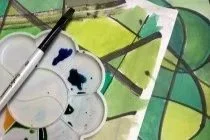Mixing characters in transparent media
WORKING WITH COLOURS:
Exploring Mixing Processes
Explore the subtractive mixing process using watercolour paints
Details:
Elementary school and up
Time: 20 minutes
Learning Outcome: Notice and describe the variety of greens produced by mixing various yellows and blues in different transparent media.
Colour Concept: In the subtractive mixing process, the final mixed colour depends on the components and the media used.
Materials: Liquid watercolours
Liquid watercolour paints: yellow, blue, and magenta
Black India ink with brush, or black marker.
Brushes, plastic palettes, cup of water, paper towels
Instructions:
Figure 1. Filling in a variety of shapes with variations on mixed greens.
Use the black ink or marker to draw shapes on the heavy paper.
Mix the yellow and blue-coloured watercolours together on the palette and make a variety of vivid and pale greens. Paint approximately half of the shapes on your paper with these various greens.
Mix small amounts of magenta-coloured paint with these greens. In this way you will create a variety of muted and dark greens.
Paint the remaining shapes on your paper with the muted and dark greens.
In some of the coloured shapes, you can paint the same colour over top; in other areas you can paint a different colour over top. This will give you even more variations of greens.
Vocabulary:
Questions & observations:
Are the mixed colours as you expected?
What’s going on?
In this exercise, subtractive mixing occurs when mixing transparent watercolour paints.
In the case of the subtractive mixing process using transparent watercolour paints, their transparency allows light to reflect off the white paper underneath the paints, back into our eyes. Therefore, transparent watercolour paints appear to sit on top of the paper which allows light to pass through them.
Find out more:
See glossary discussion on the subtractive mixing process and a thorough discussion in comparative mixing.




